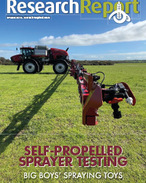This article is 3 years old. Images might not display.
The video details the best approach for the recovery of a bogged harvester using straps supplied by Central Wheatbelt Imports.
If expecting a wet, boggy harvest, growers should be prepared for recovery. The below checklist is a good start.
Keep an eye out for an article in the December issue of Farming Ahead magazine also.
Bogged harvester safe recovery checklist:
Before harvest
- Consider running drive wheel tyres in reverse. This can assist to provide traction when reversing out of a sticky situation. If running duals, consider reversing the pattern on one of the two drive wheels on each side.
- Consider adjusting tyre pressures for additional flotation to the lowest in the manufacturers' recommended range. They will need to be repressurised for roading or out-of-paddock work.
- Read the owner's manual to check for specific vehicle recovery requirements or attachment points.
- Inspect the axle for attachment points and prepare for attachment by grinding sharp edges off axle cleats.
- Consider attaching a bridle strap pre-harvest so it is easier to access without crawling in the mud once bogged. Pre-fitted steel wire rope may also be an option although ensure the rope is load rated accordingly and attach the recovery strap to the wire rope harness using a slightly lower-rated soft shackle.
When bogged
- Clear mud away as best you can - this usually involves shovel work.
- Reduce the load in the harvester if possible - this may require "tricking" the harvester by popping the outload auger out of the saddle so the outload auger can be engaged- but may require tethering the outload auger to avoid the risk of it free-fall swinging out.
- Only attach recovery cables to designated recovery points. Use a bridle if necessary. If there aren't any fixing points, axle straps may need to be used.
- Unless there is a dedicated rear recovery point, recover the harvester by pulling it backwards out of the bog with a recovery strap attached to the front axle. Pulling a harvester from the rear axle can stretch the chassis and damage the machine.
- Recovery straps should have tethers or dampeners to arrest potential energy in the recovery strap under load. If not, consider putting the recovery strap through something to arrest the recoil, for example, an old car tyre, positioning the tyre in the middle of the strap.
- Tethers should be attached to the vehicle being recovered and the recovery vehicle.
- Don't use chains - chain breaking strains are relatively low and once they break, they can be lethal.
- If the recovery strap isn't long enough, do not be tempted to join it with a metal shackle as the shackle could become a lethal projectile. Only use a soft shackle in this scenario.
- If you have a harvest weed seed impact mill on the harvester, check for recovery strap clearance. Lay a piece of ply between the mill and the recovery strap to spread the load and minimise mill damage.
- While axle straps typically have a protective sheath, additional protection may come from using a piece of old carpet or rubber around the axle
- Ensure driveshafts, choppers and mills are clear of the recovery strap in tension and remember the geometry of the recovery hardware may change as the machine comes out of the bog.
- Recovery straps have some elasticity, so begin the recovery at 2-5km/h and apply power as the load comes on.
- If using a Black-snake style kevlar-filled recovery cable, take up the strain first as these do not provide elasticity.
- Keep all observers well away from the recovery operation.
- Release all brakes, ensure the harvester is out of gear and stay in communication with a two-way radio as the recovery proceeds.























